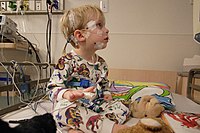
Photo from wikipedia
Narcolepsy is characterized by excessive daytime sleepiness and a tetrad of sleep attacks, cataplexy, hypnogogic/hypnopompic hallucinations, and sleep paralysis.1 In addition, fragmented sleep is also present in up to 90%… Click to show full abstract
Narcolepsy is characterized by excessive daytime sleepiness and a tetrad of sleep attacks, cataplexy, hypnogogic/hypnopompic hallucinations, and sleep paralysis.1 In addition, fragmented sleep is also present in up to 90% of persons. The prevalence of narcolepsy is between 20 and 50/100,000, or roughly 1 in 2,000, with the lowest prevalence in Israel and the highest prevalence in Japan.2 A bimodal peak for age at onset occurs, with a maximum rate of onset at 15 years and a second peak at 34 years.3 In children, the peak age is around 9 years. Several studies have shown an increased prevalence of narcolepsy in Europe and Asia after the H1N1 influenza virus pandemic in 2009, and the introduction of the vaccine against it.4 A similar increase, by 2- to 3-fold, in pediatric narcolepsy cases has also been reported in the United States.5
Journal Title: Neurology
Year Published: 2019
Link to full text (if available)
Share on Social Media: Sign Up to like & get
recommendations!